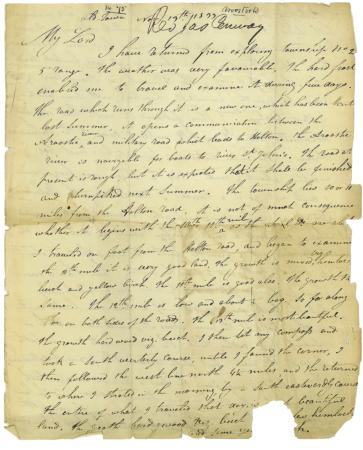
Culture
... Bishop Benedict Fenwick of Boston desired to start his own 'Catholic Utopia' that would offer an escape for poor Catholic immigrants living in the squalor of Boston's waterfront.
Now on display at the Pastoral Center in Braintree are documents related to the Benedicta Community of Maine.
During the 1830s and 1840s, there were many attempts to found new communities based upon common backgrounds or interests, one notable example being Brook Farm in West Roxbury. The Catholic community was not immune to such ideas, and Bishop Benedict Fenwick of Boston desired to start his own "Catholic Utopia" that would offer an escape for poor Catholic immigrants living in the squalor of Boston's waterfront.
After surveying several pieces of land in Maine, Bishop Fenwick was notified of an ideal location by Father James Conway, a former surveyor, in late 1833. The bishop raced north to see the area for himself, and finalized the purchase of Township Number 2, Range 5, at the southern tip of Aroostook County, on July 7, 1834. The following month, an advertisement was published in The Jesuit, or Catholic Sentinel (the earliest title of what today is The Pilot) announcing the community and the rush of settlers already making their way there.
While some settlers are believed to have arrived that first summer, many waited to see how the first wave fared, and were not encouraged to follow. After his initial interest and purchase of the land, it took Bishop Fenwick three years to visit Benedicta, named in his honor, where he found a struggling population of only 75 men, women, and children.
The visit did renew his interest, and he visited several times over the next few years, but projects such as the church, grist mill, saw mill, and dam, took years to complete, and were often poorly constructed. In addition, many of the Catholic immigrants living in Boston had already relocated once from their home countries, and were not willing to do so again.
A potential savior of the community was Bishop Fenwick's ambition to establish a seminary in Benedicta, which would not only help draw more people there, but provide native priests of which the early diocese was in desperate need. Construction of a school building began in 1839, and 500 acres were designated as a college farm, but the bishop had difficulty finding a religious order to staff a college in such a remote location.
By September 1842, Father James Fitton had successfully overseen his Mount Saint James Academy in Worcester for six years, but found the strain on his time and finances too much for one pastor, and offered to sell the school to Bishop Fenwick. He accepted, and renamed the school the College of the Holy Cross after Boston's Cathedral.
With the successful establishment of a school in Worcester, Bishop Fenwick lost interest in the idea of establishing one in Benedicta, and the completed school building was used for other purposes. His interest in the community as a whole waned, and though he continued to provide support, never visited again.
Following Bishop Fenwick's death, the community was tended to by his successor, Archbishop John J. Williams, until the Diocese of Portland was established in 1853. In 1874, the residents successfully petitioned the State of Maine to be incorporated as a town, though it never seems to have thrived in the way Bishop Fenwick had hoped. In 1987, the 225 residents voted to dissolve the town, at which time it was reclassified as an unorganized territory, and supported by the county and state governments.
THOMAS LESTER IS THE ARCHIVIST OF THE ARCHDIOCESE OF BOSTON.
Recent articles in the Culture & Events section
-
'Dignitas' and the mediaRussell Shaw
-
Scripture Reflection for April 14, 2024, Third Sunday of EasterDeacon Greg Kandra
-
St. Helena's House is established in the South EndThomas Lester
-
Is this synodality?Russell Shaw
-
Poking the hornet's nest of IVFFather Tadeusz Pacholczyk


















